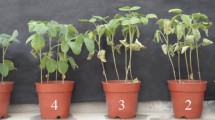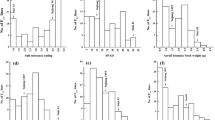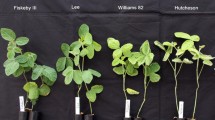Abstract
To identify quantitative trait loci (QTLs) conditioning salt tolerance in soybean (Glycine max (L.) Merr.), two recombinant inbred line (RIL) populations derived from crosses of FT-Abyara × C01 and Jin dou No. 6 × 0197 were used in this study. The FT-Abyara × C01 population consisted of 96 F7 RILs, and the Jin dou No. 6 × 0197 population included 81 F6 RILs. The salt tolerant parents FT-Abyara and Jin dou No. 6 were originally from Brazil and China, respectively. The QTL analysis identified a major salt-tolerant QTL in molecular linkage group N, which accounted for 44.0 and 47.1% of the total variation for salt tolerance, in the two populations. In the FT-Abyara × C01 population, three RILs were found to be heterozygous around the detected QTL region. By selfing the three residual heterozygous lines, three sets of near isogenic lines (NILs) for salt tolerance were developed. An evaluation of salt tolerance of the NILs revealed that all the lines with FT-Abyara chromosome segment at the QTL region showed significantly higher salt tolerance than the lines without the FT-Abyara chromosome segment. Results of the NILs validated the salt tolerance QTL detected in the RIL populations.





Similar content being viewed by others
References
Abel GH (1969) Inheritance of the capacity for chloride inclusion and chloride exclusion by soybeans. Crop Sci 9:697–698
Abel GH, MacKenzie AJ (1964) Salt tolerance of soybean varieties (Glycine max L. Merill) during germination and later growth. Crop Sci 4:157–161
Asagawa M (1985) Hydroponics. In: Hozyo Y, Ishizuka J (eds) Experimental method of crop physiology (in Japanese). Nougyo Gijyutsu Kyokai, Japan, pp 388–389
Chen H, Cui S, Fu S, Gai J, Yu D (2008) Identification of quantitative trait loci associated with salt tolerance during seedling growth in soybean (Glycine max L.). Aust J Agr Res 59:1086–1091
Delourme R, Piel N, Horvais R, Pouilly N, Domin C, Vallée P, Falentin C, Manzanares-Dauleux MJ, Renard M (2008) Molecular and phenotypic characterization of near isogenic lines at QTL for quantitative resistance to Leptosphaeria maculans in oilseed rape (Brassica napus L.). Theor Appl Genet 117:1055–1067
Doyle JJ, Doyle JL (1990) Isolation of plant DNA from fresh tissue. Focus 12:13–15
Hamwieh A, Xu DH (2008) Conserved salt tolerance quantitative trait locus (QTL) in wild and cultivated soybeans. Breeding Sci 58:355–359
Hisano H, Sato S, Isobe S, Sasamoto S, Wada T, Matsuno A, Fujishiro T, Yamada M, Nakayama S, Nakamura Y, Watanabe S, Harada K, Tabata S (2007) Characterization of the soybean genome using EST-derived microsatellite markers. DNA Res 14:271–281
Hymowitz T, Newell CA, Carmer SG (1977) Pedigrees of soybean cultivars released in the United States and Canada. International Agricultural Publications, INTSOY Series no 13. University of Illinois, Urbana-Champaign, Illinois, USA
Lee GJ, Boerma HR, Villagarcia MR, Zhou X, Carter TE Jr, Li Z, Gibbs MO (2004) A major QTL conditioning salt tolerance in S-100 soybean and descendent cultivars. Theor Appl Genet 109:1610–1619
Lee JD, Shannon JG, Vuong TD, Nguyen HT (2009) Inheritance of salt tolerance in wild soybean (Glycine soja Sieb. and Zucc.) accession PI483463. J Hered 100:798–801
Maeda H, Matsushita K, Iida S, Sunohara Y (2006) Characterization of two QTLs controlling resistance to rice stripe virus detected in a Japanese upland rice line, Kanto72. Breeding Sci 56:359–364
Parker MB, Gascho GJ, Gains TP (1983) Chloride toxicity of soybeans grown on Atlantic Coast flatwoods soils. Agron J 75:439–443
Salvi S, Tuberosa R (2005) To clone or not to clone plant QTLs: present and future challenges. Trends Plant Sci 10:297–304
Singleton PW, Bohlool BB (1984) Effect of salinity on nodule formation by soybean. Plant Physiol 74:72–76
Song QJ, Marek LF, Shoemaker RC, Lark KG, Concibido VC, Delannay X, Specht JE, Cregan PB (2004) A new integrated genetic linkage map of the soybean. Theor Appl Genet 109:122–128
Tuyen DD, Lal SK, Xu DH (2010) Identification of a major QTL allele from wild soybean (Glycine soja Sieb. & Zucc.) for increasing alkaline salt tolerance in soybean. Theor Appl Genet 121:229–236
Van Ooijen JW (2004) MapQTL®5, Software for the mapping of quantitative trait loci in experimental populations. Kyazma BV, Wageningen
Van Ooijen JW (2006) JoinMap® 4, Software for the calculation of genetic linkage maps in experimental populations. Kyazma BV, Wageningen
Wang D, Shannon MC (1999) Emergence and seedling growth of soybean cultivars and maturity groups under salinity. Plant Soil 214:117–124
Wissuwa M, Ae N (2001) Further characterization of two QTLs that increase phosphorus uptake of rice (Oryza sativa L.) under phosphorus deficiency. Plant Soil 237:275–286
Yamaguchi T, Blumwald E (2005) Developing salt-tolerant crop plants: challenges and opportunities. Trends Plant Sci 10:615–620
Yamanaka N, Watanabe S, Toda K, Hayashi M, Fuchigami H, Takahashi R, Harada K (2005) Fine mapping of the FT1 locus for soybean flowering time using a residual heterozygous line derived from a recombinant inbred line. Theor Appl Genet 110:634–639
Yang J, Blanchar RW (1993) Differentiating chloride susceptibility in soybean cultivars. Agron J 85:880–885
Author information
Authors and Affiliations
Corresponding author
Rights and permissions
About this article
Cite this article
Hamwieh, A., Tuyen, D.D., Cong, H. et al. Identification and validation of a major QTL for salt tolerance in soybean. Euphytica 179, 451–459 (2011). https://doi.org/10.1007/s10681-011-0347-8
Received:
Accepted:
Published:
Issue Date:
DOI: https://doi.org/10.1007/s10681-011-0347-8




